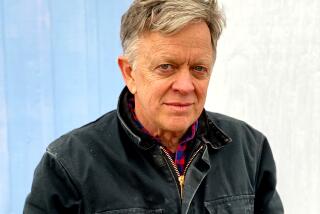Ted Conoverâs âThe Routes of Man: How Roads Are Changing the World and the Way We Live Todayâ
The Routes of Man
How Roads Are Changing the World and the Way We Live Today
Ted Conover
Alfred A. Knopf, 334 pp., $26.95
An editor with whom I once worked dismissed undercooked ideas by saying, âThatâs a notion, not a story.â Ted Conoverâs new book âThe Routes of Man: How Roads Are Changing the World and the Way We Live Todayâ has notion written all over it. Itâs about highways and streets and pathways and what they tell us about progress and war and trade and humanity.
âNotion,â the editor would have said.
And yet, he probably would have taken a chance that Conover, one of Americaâs most intrepid journalists, could spin this rough concept into gold. For his last book, the Pulitzer Prize finalist âNewjack,â Conover spent almost a year as a rookie corrections officer at New Yorkâs maximum security Sing Sing prison. He got hazed by his superiors and knocked around by the inmates -- and found himself doing some knocking around in return.
âNewjackâ combined harrowing storytelling with a damning message about the failings of our corrections system. âThe Routes of Man,â despite its notional premise, is no less gripping and provocative.
Over six chapters, Conover travels roads in Peru, India, Kenya, the West Bank, China and Nigeria in trucks, taxis, cars, an ambulance and on foot. Early on, he acknowledges his visceral attraction to the road, the early pleasure he took in hitchhiking, his youthful love of Kerouac and Whitman, but this is refreshingly nonromantic road writing. What Conover has brought back is a clear-eyed understanding that roads confine as much as they liberate, that they make the world more accessible but also infinitely more dangerous and exploitable. Perhaps the only certainty he offers is that these âpaths of human endeavorâ are inevitable: âThey are the infrastructure upon which almost all other infrastructure depends.â
Conover is not interested in the super-smooth tarmac of an American interstate or a German autobahn; in the first chapter here, he makes his torturous way over the Peruvian Andes, riding shotgun in a âtandem rigâ from Lima up to Cuzco, and back down in a smaller tanker truck to Puerto Maldonado in the Amazon basin. Reversed, this is the path that prized big-leaf Peruvian mahogany travels from portable sawmills (which Conover vividly describes) to ports in Lima and eventually the âhigh WASPâ apartments of Park Avenue. As Conover climbs with Sebastian and Edgardo (just two of his memorable travel companions) he worries about nighttime bandits, spots Osama bin Laden T-shirts for sale in mountain villages and, as they ascend to passes above 14,000 feet, endures a nightmarish bout of altitude sickness.
Jeopardy in one form or another punctuates every chapter of the book. In Zanskar, a remote Himalayan valley in India, Conover follows youngsters from the village of Reru along a frozen river through a deep gorge, the villagersâ sole link to the outside world -- and open only in winter. Itâs bad enough that this ice road, or chaddar, makes for slippery walking; worse, unseasonably high temperatures cause the ice to crack and break under Conoverâs feet. Engineers plan to drill an all-season alternative through the high walls of the gorge, but progress is excruciatingly slow. And would a proper road be progress at all? Would the Zanskari customs that endure in isolated Reru be lost? Itâs a classic globalism debate that Conover navigates with level-headed skill.
In China, an exploding highway network and emerging, passionate car culture mean carbon dioxide emissions from the transport sector are predicted to be highest in the world by 2030. (The countryâs highways are already the deadliest in the world.) Yet Conoverâs experiences in one of Beijingâs new driving clubs, which he joins for a 1,000-mile circuit south through Hubei Province, are the most amusing in the book. His uncouth driving partner Zhu spits, snores, hires massage girls in the hotel rooms they share -- and speeds like a maniac. When Conover, terrified, asks through a translator if Zhu will slow down, he steps on the gas.
Despite the risks of driving in China, Lagos -- the city in Nigeria that is the setting for Conoverâs final and most engrossing chapter -- seems worse. This mushrooming mega-city features near-24-hour gridlock, corrupt traffic cops and marauding âarea boys,â homeless gang members who intimidate and rob stalled drivers and give Conover a couple of bad scares as he tags along with a new mobile ambulance squad. Conover spends one evening in a local ER where gunshot gang members seek treatment and occasionally draw down on one another. A photo reproduced in the book shows a sign taped to the ER door: GUNS ARE NOT ALLOWED.
Despite his apparent fearlessness, Conover, thankfully, is no cowboy journalist. His modesty and compassion make âThe Routes of Manâ less a series of travel adventures than an empathetic look at the contradictory effects of modernity. Speaking of those effects: Traditional print magazines such as the Atlantic and National Geographic published and helped pay for much of Conoverâs work -- but will the biggest road of them all, the information superhighway, put these print dinosaurs out of business? Conover doesnât weigh in on that, except to remind us that roads, good and bad, are inevitable, and that âstasis is not an option.â
Antrim is the author of the novel âThe Headmaster Ritual.â
More to Read
The biggest entertainment stories
Get our big stories about Hollywood, film, television, music, arts, culture and more right in your inbox as soon as they publish.
You may occasionally receive promotional content from the Los Angeles Times.









